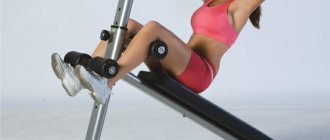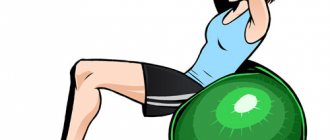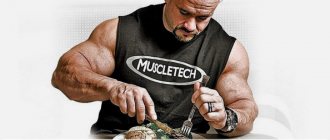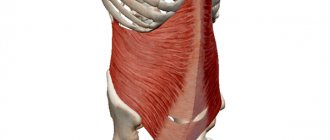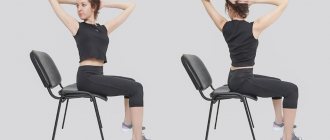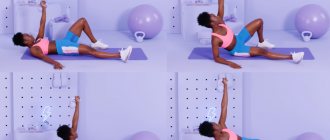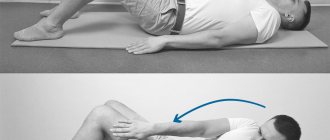The abdominal muscles form the anterior wall of the abdominal cavity and are in close interaction with each other. The structure of the abdominal wall can be divided into two parts, each of which acts differently. The anterior wall of the abdominal cavity is formed by the rectus abdominis muscle. The lateral walls of the abdomen consist of three layers of muscles. The lowest layer is formed by the transverse muscle. The middle layer is formed by the internal oblique abdominal muscle. At the very top is the external oblique abdominal muscle.
Contraction of the oblique abdominal muscles on one side of the body causes a lateral tilt of the torso. The simultaneous contraction of the oblique muscles on both sides helps the rectus abdominis muscle tilt the torso forward and at the same time gives strength to the walls of the abdominal cavity if there is a need to lift heavy weights.
External oblique abdominal muscle[edit | edit code]
External oblique muscle
Home[edit | edit code]
- Eight teeth from the outer surface of the V-XII ribs
Attachment[edit | edit code]
- Linea alba
- External lip of the iliac crest
- Inguinal ligament
- Pubic tubercle
- pubic ridge
Training[edit | edit code]
Read separate article:
Press exercises and training features
Innervation[edit | edit code]
- Intercostal nerves, T5-T12
- Iliohypogastric nerve, T12-L1
- Ilioinguinal nerve, L1
The best exercises for the oblique abdominal muscles for home and gym
Let's look at the top 3 exercises to work the oblique abdominal muscles, which can be performed in any conditions. It should be noted that each of the three types of movement has many variations. Therefore, it is worth considering only classic exercises for the oblique abdominal muscles, and not their subtypes.
Hanging leg raises with abduction
The movement is great not only for pumping up the lateral abdominal muscles, but also for properly working out the lower abdomen.
Technique:
- Hang on a horizontal bar or in an exercise machine with an elbow support.
- Slowly raise your knees bent to the right side (try to move your legs as far as possible).
- Pause and slowly lower your legs, performing the same movement on your left side.
In this exercise for the side press, it is important to ensure that the body does not sway and that the legs are lifted using the side press.
Leg lifts can also be performed with a turn at the top point. To do this, the legs are raised straight (bent at the knees), after which at the top point they are rotated to the sides alternately. This is a more difficult version of the exercise.
Crunches
This is a whole group of exercises for the oblique muscles, which include:
- Lying crunches.
- On a Roman chair.
- Exercise “book” lying on the floor.
- Exercise “prayer” (with weight and rope handle).
- Lying lateral crunches.
Even though these are different exercises, they all belong to the same type of movement. They are united by technical features:
- The housing must be securely fixed.
- In each movement, jerks, inertia or fast pace of execution are excluded.
- Twists are performed as much as possible as physical capabilities allow (but without strong rounding of the back).
- At the peak point there should be an exhalation and a short pause.
Otherwise, the technique will depend on the position and characteristics of the specific movement.
Standing/sitting body rotation
Another group of similar exercises that have the same principle is performing torso rotation. This is precisely the function of the external oblique abdominal muscle. Unlike other movements, rotations are performed at a moderate or even fast (relatively) pace. The group includes:
- Russian twist with a disc or dumbbells while sitting.
- Rotate the disc laterally while standing.
- Exercise “lumberjack” in a crossover or with a rubber band.
- Rotating a fitball while standing.
You can also perform regular dumbbell bend-overs separately, although this movement is not very effective for the target area. Moreover, it is precisely this that girls who do not want to increase their waist should be afraid of. A static load from a side plank is ideal to complete your workout.
Participation in sports[edit | edit code]
As an important rotator of the torso, this muscle takes an active part in athletics exercises - throwing and pushing - in the final phase of movements during which the torso rotates (shot put, hammer throw, javelin, discus). In addition, she performs trunk rotation in kayaking, snowboarding, skateboarding, gymnastics, figure skating, diving, boxing and fencing. When bending the body, it performs both dynamic (fencing and boxing) and static work (maintaining a pose), for example, when shooting from a rifle. With bilateral contraction, this muscle flexes the torso along with the rectus abdominis muscle. Participates in maintaining a straight body position when playing many sports.
| Kind of sport | Movement/hold | Function | Load | Types of abbreviations |
| Shot put, hammer throw, javelin throw, discus throw | Throw phase | Torso rotation | Fast, explosive | Dynamic concentric |
| Kayaking | Turn trunk to support upper limb movements | Torso rotation | Strength endurance | Dynamic concentric |
| Snowboarding, skateboarding | Entering a turn | Torso rotation | Fast, strength endurance | |
| Artistic gymnastics, figure skating, diving | Jumps with a twist or turn | Torso rotation | Fast, explosive | Dynamic concentric |
| Boxing | Participates in attacking strikes, dodging, pendulum movements | Torso rotation | Fast, explosive | |
| volleyball, handball, tennis | Attacking blow, overhead throw, serve, forehand | Torso rotation | Fast, explosive | Dynamic concentric |
| Long jump, high jump, pole jump, triple jump, artistic and sports diving, artistic gymnastics, rowing, football, javelin throwing, contact sports (boxing, judo) | Torso flexion (see “Rectus abdominis”) | Dynamic | ||
| Various sports, such as artistic gymnastics, weightlifting, boxing, fencing, alpine skiing, speed skating, table tennis | Keeping your torso straight | Torso flexion | Strength endurance | Static |
General functions of the abdominal muscles
- When fixing the pelvis, the torso is tilted forward or backward.
- When fixing the upper body, bend and raise the legs.
- When fixing the pelvis and spine, pull the chest down, facilitating exhalation.
- Helps increase the active strength of the muscles extending from the pelvis to the lower extremities.
- They have a great influence on keeping the abdominal organs in the correct position.
- They are antagonists of the rectifiers of the trunk, affecting posture.
Read also[edit | edit code]
- Muscles - anatomy and functions
- Abdominal muscles
- Core muscles
- Rectus abdominis muscle
- Internal oblique muscle
- Levator testis muscle
- Transverse abdominis muscle
- Quadratus lumborum muscle
- Press exercises and training features
- How to pump up powerful abs
- An effective abdominal training technique
- Abdominal muscle training
- Exercises for the abs
- Abdominal exercises for girls
- Home exercises for the abs
- Cubes on the stomach
- Abs workout for back pain
- Training for terrain
Rules and features
When developing side presses, you should follow some rules, since their development can affect your figure:
It is not recommended to exercise after a heavy lunch. If you perform complex exercises for the oblique muscles, dizziness and nausea may occur. Therefore, it is recommended to start doing them 2 hours after eating. This time is quite enough for the food to be digested. You should not exercise on an empty stomach, since the body requires a certain amount of energy for a productive workout.
Before classes, you should warm up your whole body. Physical activity in any form puts stress on the entire body. Failure to warm up the muscles can lead to injury. To prevent this, it is necessary to carry out a set of warm-up exercises. Particular attention needs to be paid to those muscles that will be used during training. To do this, it will be enough to perform exercises in the form of body rotations and bending.
It is not quantity that matters, but quality. Most people make the mistake of doing abdominal crunches many times. To develop the lateral muscles, 10 repetitions in one approach are enough. The main condition is that you feel exactly the muscle group that you want to load. Therefore, it is necessary to work to develop neuromuscular connections.
Excessive load. Even though the abdominal muscles are strong and require a little time to recover, it is not recommended to overload them. This is why daily muscle training would be a big and blunder. 2 lessons per week are enough.
Correct diet. Despite constant training, without proper nutrition it is impossible to achieve the desired result, since due to the high percentage of subcutaneous fat, the abdominal muscles will simply not be noticeable. This is why it is recommended to change your diet during training to get a positive effect.
The training should be done differently. Since the abdominal muscles are very fastidious, they are able to get used to the same type of training in a short period of time. Therefore, exercises should be diluted with different and new activities. Each lesson provides an opportunity to complete it in an easier and more accessible form. Thanks to this, you don’t have to worry about not being able to do any element if the oblique muscles have not been trained before.
Stretching at the end of your workout. After each session, it is necessary to stretch the working muscles, including the abs. This is necessary to improve blood circulation and normalize the central nervous system after grueling work in the gym. Thanks to this, muscle pain and recovery will decrease faster. Therefore, after each workout, it is recommended to devote at least 5 minutes to this process.
Contraindications and possible harm
Girls are strictly prohibited from doing abdominal training during pregnancy and in the first 4 weeks after childbirth. It is not recommended to do exercises if you have spinal diseases. In this case, you should use static loads in the form of a horizontal bar or vacuum.
Training can be harmful if:
- gastrointestinal diseases;
- diseases of the cardiovascular system;
- joint diseases;
- infectious diseases.
Exercises should begin no earlier than 3 hours after eating, and food should be consumed after training after 1 hour.
To avoid negative health consequences, it is recommended to start abdominal training only after consulting a fitness instructor or sports doctor.
Abdominal exercises are very important. Therefore, they should be performed competently, slowly and at a slow pace. Before training, you need to warm up your body well and stretch all your muscles. This will help avoid many unpleasant injuries.
If you do not follow the exercise technique, you may receive the following types of injuries:
- Prolonged aching pain. It manifests itself if a person exercises very often. It is necessary to take breaks between workouts, since it is at this moment that the muscle fibers are restored and prepared for new physical activity.
- Stretching. The problem is very common, and it can be acquired in case of too intense training. Sharp pain in the abdominal area and discomfort when bending the back indicates muscle injury. Additionally, bruising and a rise in body temperature are possible. It is possible to restore muscle tissue individually, depending on the degree of complexity of the resulting sprain.
Pain in the abdominal area can very often occur not due to sprains or severe overtraining, but due to a normal draft. In any case, if a person experiences discomfort during or after training, you should contact a specialist to determine the cause and get qualified help.
Possible complications
In the case of neuromuscular disorders, complications cannot be avoided due to the progression of the disease. Over time, this will lead to immobilization of the patient. Death occurs due to atrophy of the respiratory muscles.
A delayed complication of open wounds may be their suppuration and scarring. Surgeons try to make neat stitches, wash the wound as much as possible and do regular dressings. But there is always a risk that the wound will fester: you will have to do a second operation, but there will no longer be a guarantee of a beautiful seam.
If treated incorrectly, tears and sprains can turn into contractures. In this state, the muscle is nonfunctional, and every attempt to use it will be painful.
The abdominal muscles are rarely subject to injury and disease: the back and lower leg areas remain the leaders in traumatology. The external oblique muscle quickly recovers from injuries and wounds, and qualified doctors will help this process proceed comfortably for the patient.
Main complex
Girls' oblique abdominal muscles will become prominent if they are constantly trained. As a result, you can achieve a beautiful waist by making a powerful muscle corset.
Below are the most effective exercises for swinging the side press.
V-shaped body lifts
To perform the exercise you must adhere to the following steps:
- You need to lie on the floor and rest your shoulder blades on the covering, making your body level.
- Squeezing your legs, they should be raised about 25 cm.
- Then you need to place your arms along the body, raising your shoulder blades (starting position).
- When inhaling, you must simultaneously raise your chest and legs, squeezing the latter at the knees at an angle of 90 °.
- Next you need to straighten up to the starting position.
- The exercise consists of 15 repetitions of 4 sets. It is recommended to take a short break between approaches.
Classic sit-ups
To carry out the exercise, you must comply with the movements indicated below:
- Lying on your back, you need to tuck your knees.
- Having placed your palms on the back of your head, you will need to spread your elbows (starting position).
- About 20 times it is required to lift the chest to the knees. Movements should be quick and short. The workout includes 4 sets with a minute of rest.
Scissors
The exercise is based on the following steps:
- Lying on your back, you will need to place your arms along your body, fixing your palms under your buttocks.
- Having closed your feet, they should be raised 20 cm from the floor (the starting position).
- You will need to perform about 20 cross swings with your legs. The lesson consists of 5 sets with a rest of 45 seconds.
Bike
To perform the workout, you must adhere to the following technique:
- Initially, you need to lie with your stomach up, placing your palms on the back of your head and spreading your elbows.
- Having straightened your legs, you will need to squeeze them.
- Next, you need to take the initial position, raising your feet from the floor by about 35 cm.
- About 20 times you will need to touch your left elbow to your right knee and vice versa.
- After 75 sec. pauses, you need to repeat the workout 4 times.
Raising legs while hanging on the horizontal bar
To carry out the exercise you will need to do the following:
- You need to grab the crossbar with your hands, hanging on the horizontal bar. Next, you should stretch your feet, closing your legs.
- As you exhale, you need to sharply raise your legs upward. As you inhale, you need to slowly return the lower body back.
- The workout consists of 10 lifts with 3 sets.
Side crunches
To perform side crunches, you will need to do the following:
- You need to lie on your left side, pulling your shins towards your buttocks.
- The right palm should be placed on the back of the head, and the left hand should be placed on the abdominal area (considered the starting position).
- With the right shoulder blade you need to do 15 twists to the pelvis. Movements should be short and quick. Then the exercise must be repeated on the right side. The lesson includes 4 sets.
Raising legs from a side lying position
To conduct the lesson you will need the following:
- You will need to lie on your left side, holding your head with your left hand and fixing your right hand on your waist.
- It is required to perform 25 lifts with the right leg, and then with the left.
- The workout includes 5 approaches with a minute of rest.
Side plank pelvic lift
The exercise is based on the following manipulations:
- You need to lie on your left side, resting your feet and left palm on the floor.
- Then you should straighten your body at the same level, raising the center of your body up.
- Next, you will need to slowly lift your pelvis up and gently lower it. There should be 15 repetitions.
- Then the exercise must be performed on the right side. The workout consists of 3 sets.
Side bends from a lying position
To perform the exercise correctly, it is recommended to adhere to the following steps:
- You will need to lie on your back, tuck your legs at the knees, and place your arms along your body.
- The shoulder blades should be raised 10 cm (initial position).
- It is necessary to alternately tilt the body to the left and to the right, touching the shins with the palm of the hand.
- The exercise consists of 5 sets of 25 repetitions.
Twist in plank
The lesson consists of the following movements:
- You need to lie on your left side, resting your left elbow on the floor, and fixing your right palm on the back of your head.
- The body should be straight and the pelvis raised upward.
- The chest should be turned to the left, bringing the right elbow together with the left forearm. Afterwards you need to take the starting position. The repetitions should be 20 with 4 sets. After each set you need to take a short break.
Abdominoplasty - tummy tuck with Abrielle
The services of plastic surgeons are intended not only for women, but also for the stronger sex. The problems are often the same, and they can be solved in just a few hours spent on the operating table. Abdominoplasty is no exception. It allows you to get rid of fat folds, remove excess skin and fat tissue and gain an ideal shape.
EFFECTIVENESS OF ABDOMINOPLASTY
Many patients wonder how effective abdominoplasty is and how long the results of the operation last. Surgeons assure that with the right lifestyle it will last for many years. If you add regular exercise and a healthy diet, you can forever forget about the hated fat folds and sagging skin. As a result of the intervention, you will get a flat, beautiful and elastic stomach, which you are not ashamed to show off in open clothes. Should you decide to have surgery? The choice is always yours. The benefits of an ideal figure cannot be underestimated - people with an attractive body are more successful, self-confident and popular with the opposite sex. In addition, removing a heavy “apron” relieves a person of problems with the heart and joints, gives lightness and good health
REHABILITATION AFTER ABDOMINOPLASTY
As a result of the operation, a fairly large wound surface is formed. This requires drainage of the space between the muscles and the detached skin-fat flap, as well as the use of an elastic compression mode. The wound drainage period is usually 3-5 days, but it can be extended if necessary.
The requirements for the quality of compression garments (belts or jumpsuits) are quite high - you shouldn’t skimp on them. A multi-band postoperative bandage fits better and reliably prevents the formation of lymphatic lakes or postoperative seromas. The duration of use of a compression bandage is determined by the volume of surgical intervention performed and the thickness of the patient’s subcutaneous fat tissue. Typically, the elastic compression regimen lasts one month. The surgeon removes some of the sutures 10-12 days after the operation, the main sutures are removed on the 15-16th day. After this, application of silicone and paper patches is recommended. They can improve the quality and texture of postoperative scars and make them invisible.
For the next 2 weeks after surgery, physical activity is excluded, and hot baths should also be avoided for 2-3 months. During the rehabilitation period, there may be a decrease in sensitivity at the incision sites. After several months (up to 6-8) it returns completely. The postoperative suture gradually becomes pale and thin, and after 6-12 months you will no longer notice it at all.
WHY SHOULD ABDOMINOPLASTY BE DONE AT THE ABRIELLE CLINIC?
You should trust your health and appearance only to the best doctors - this is the only way you can protect yourself from possible risks and negative consequences. The Abrielle Clinic is deservedly recognized as one of the best in Russia for performing abdominoplasty. We continuously introduce new technologies and use the most modern techniques to ensure that every patient is 100% satisfied with the result. Our surgeons strictly comply with all standards, provide an individual approach and competently assess all risks. We employ only qualified specialists with many years of experience in performing abdominoplasty. They are able to turn insecure patients with external defects into healthy and attractive people who know their worth. The legendary Michelangelo was once asked how he managed to create such masterpieces. His answer was striking in its simplicity: “Very simple. I take a stone and cut off everything unnecessary!” Our best plastic surgeons do the same thing - eliminate flaws, emphasizing advantages. Contact the Abrielle Clinic and we will help you achieve your ideal.
